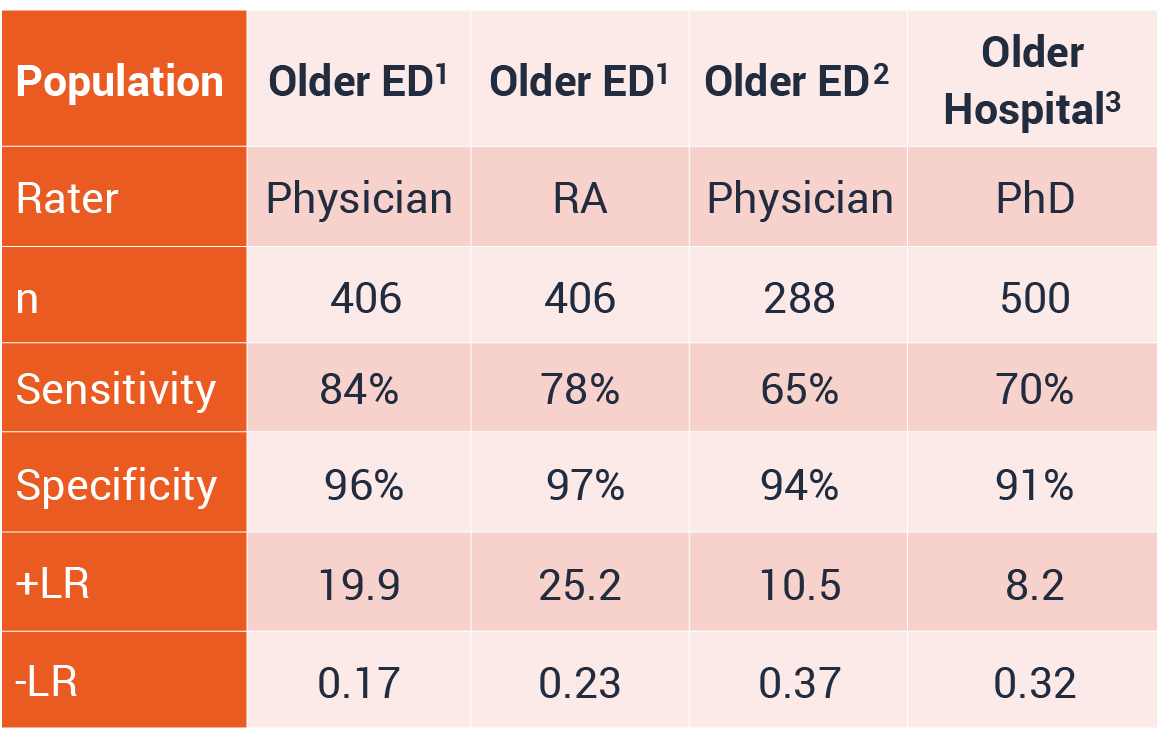bCAM (1 minute)
The brief Confusion Assessment Method (bCAM) uses the CAM algorithm
A patient must be positive for both Features 1 and 2, and either Feature 3 or 4 to be classified bCAM-positive. The bCAM is a modification of the CAM-ICU (see CAM Derivatives). The modifications were designed to increase sensitivity.
 1Han JH, et al. Ann Emerg Med. 2013;62(5):457–465.
1Han JH, et al. Ann Emerg Med. 2013;62(5):457–465.2Baten V, et al. Acad Emerg Med. 2019:[in press].
3Hendry K, et al. Age Ageing. 2016;45(6):832–837.
bCAM, brief Confusion Assessment Method
ED, emergency department
LR, likelihood ratio
RA, research assistant
Using the bCAM
Like the CAM, altered mental status or fluctuating course (Feature 1) is determined by proxy interview or observation.
To test for inattention (Feature 2), the bCAM asks the patient to recite the months backwards from December to July.
To test for disorganized thinking (Feature 3), it asks the patients 4 simple yes/no questions (eg, “Will a stone float on water?”) and a simple command (eg, “Hold up this many fingers…” [Rater holds up 2 fingers] “Now do the same thing with the other hand” [Do not demonstrate]).
Altered level of consciousness (Feature 4) is determined by the Richmond Agitation Sedation Scale (RASS). For the RASS, a score other than 0 (normal and alert) is indicative of an altered level of consciousness.
Advantages and disadvantages of the bCAM
ADVANTAGES
- Brief
- Inattention and disorganized thinking determined objectively
- Less operator dependent and requires less training
- High specificity
DISADVANTAGES
- Moderate sensitivity
- Limited external validation in ED patients
NOTE
The bCAM has limited validation data, especially in the ED.
In general, the bCAM is considered to be a moderately sensitive delirium assessment with excellent specificity. Based upon its likelihood ratios, a negative bCAM will moderately reduce the likelihood of delirium, while a positive bCAM will moderately to strongly increase the likelihood of delirium.
Given the limited number, additional validation studies are still needed to fully characterize the bCAM’s diagnostic accuracy in older ED patients.
Resources
Additional details of the bCAM, including the instruction manual and videos, can be seen at www.eddelirium.org.
Abbreviations
bCAM, bBrief Confusion Assessment Method
ED, emergency department
